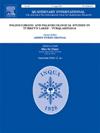Active faulting of the southern segment of the Rhine River Fault, southern Germany: Geomorphological and paleoseismological evidence
IF 1.9
3区 地球科学
Q3 GEOGRAPHY, PHYSICAL
引用次数: 0
Abstract
Our study focuses on the southern segment of the Rhine River Fault, located in one of the most seismically active regions in intraplate Europe, at the southern end of the Upper Rhine Graben and forming part of the eastern Rhine Graben Boundary Fault. It stands out due to its impressive geomorphological expression in the landscape near the village of Tunsel, in southwestern Germany. We present details about the timing of fault activity and the contribution of earthquakes to the morphology, as this information is crucial for seismic hazard assessment, considering its location 8 km from the Fessenheim Nuclear Power Plant. Through the integration of the sedimentary sequences, morphotectonic observations, shallow geophysics, and paleoseismological trenching, our findings demonstrate that several earthquakes along the RRF have ruptured the surface (M6.7 ± 0.5). The youngest surface rupturing earthquake occurred during medieval times (EZ) and the penultimate event (EY) is constrained by stratigraphic correlation with reworked Loess deposits dated to the Younger Dryas (ca. 13 kyr BP). Three older earthquake events have also been unearthed (EX, EW and EV) occurring prior to the Late Glacial Maximum, where event EX led to considerable lateral spread at the banks of the Pleistocene Rhine river. Vertical displacements reach up to 0.5 m and lateral offsets up to max. 1.5 m per earthquake event, consistently with a 15 - 30 km-long rupture of this segment of the Rhine River Fault.
德国南部莱茵河断裂带南段的活动断裂:地貌和古地震证据
我们的研究重点是莱茵河断层的南段,它位于欧洲板块内地震最活跃的地区之一,位于上莱茵河地堑的南端,构成了东部莱茵河地堑边界断层的一部分。它在德国西南部Tunsel村附近的景观中表现出令人印象深刻的地貌。我们详细介绍了断层活动的时间和地震对形态的贡献,因为这些信息对于地震危害评估至关重要,考虑到它的位置距离Fessenheim核电站8公里。综合沉积层序、形态构造观测、浅层地球物理和古地震沟堑等资料,研究结果表明,沿RRF发生了多次地震,导致地表破裂(M6.7±0.5)。最年轻的地表破裂地震发生在中世纪(EZ),而倒数第二次地表破裂地震(EY)受到地层对比的限制,地层对比可追溯到新仙女木期(约13 kyr BP)的黄土矿床。还发现了发生在晚冰期极大期之前的三个更古老的地震事件(EX、EW和EV),其中EX事件导致了更新世莱茵河河岸相当大的横向扩展。垂直位移可达0.5米,横向偏移最大。每次地震1.5米,与莱茵河断层这段15 - 30公里长的断裂一致。
本文章由计算机程序翻译,如有差异,请以英文原文为准。
求助全文
约1分钟内获得全文
求助全文
来源期刊

Quaternary International
地学-地球科学综合
CiteScore
5.60
自引率
4.50%
发文量
336
审稿时长
3 months
期刊介绍:
Quaternary International is the official journal of the International Union for Quaternary Research. The objectives are to publish a high quality scientific journal under the auspices of the premier Quaternary association that reflects the interdisciplinary nature of INQUA and records recent advances in Quaternary science that appeal to a wide audience.
This series will encompass all the full spectrum of the physical and natural sciences that are commonly employed in solving Quaternary problems. The policy is to publish peer refereed collected research papers from symposia, workshops and meetings sponsored by INQUA. In addition, other organizations may request publication of their collected works pertaining to the Quaternary.
 求助内容:
求助内容: 应助结果提醒方式:
应助结果提醒方式:


